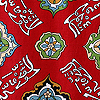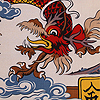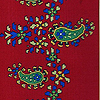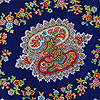 |

3324
Antique American Silk Textile Sample By Cheney Brothers, Circa 1920
Size 13" x 8"
Size 33 x 20cm
12 Pieces below in 12 colors
More information Below about Cheney Brothers, Silk Textiles
|
 American Silk Textiles Cheney Brothers American Silk Textiles Cheney Brothers
 Cheney Brothers Silk, South Manchester,
Cheney Brothers Silk, South Manchester,
Connecticut
Cheney Brothers Silk Mills from The Story of Silk and Cheney Silk, 1916
The first silk mill in the United States was begun by Rodney and Horatio Hanks, at Mansfield, Connecticut in
1810. The “mill” was only 12 ft by 12 ft in size. The mill made sewing thread by adding twist on machines of
their design run by water power. The mill and two others associated with this venture were abandoned in 1828
because the machinery was too crude to produce commercial sewing thread. In 1815, William H. Horstmann,
built a mill in Philadelphia for production of trimmings and ribbons. He imported a Jacquard loom in 1824. The
Mansfield Silk Company, begun in the center of the silk growing district, made use of water power for reeling,
but was unsuccessful in attempts at weaving. The mill failed as a result of failure in the speculation with the
morus multicaulis.
The first really successful manufacturers in the United States were the Cheney Brothers. The original mill was
begun as the Mt. Nebo Silk Mills, South Manchester, Connecticut, in January, 1838. Although somewhat
neglected during the time of the morus multicaulis speculation, it is the only mill established before that date
that was permanently successful.
The story of the Cheney silk mills is typical of the growth of the industry, and, even more than that, of the
development of the United States from an agricultural to a manufacturing country. One must remember that
England wanted the colonies and the new States to remain suppliers of raw materials and held all mechanical
developments for internal use. Samuel Slater carried the plans for his textile enterprise out of England in his
head. A number of details of the crude beginnings of the factory system by the Cheney Brothers were preserved
in their diaries. 
Effect of Tariffs The tariff that was put on silk goods during the war made it possible to develop the weaving of
silk far more extensively in this country. Cheney Brothers began the weaving of ribbons on a large scale in
1861 and of grosgrains in 1866. In manufacturing industries, it is indisputable that while inventions have
multiplied wages, these same inventions and competition have lowered prices, in spite of the tariff. In many
cases it is only that tariff that made the development of the industry possible at all in this country.
The company prospered. Additional spinning mills were built in 1872. In 1873, the name of the company was
changed from Chaney Brothers Manufacturing Company to simply Cheney Brothers. In 1880, the company
began weaving plush and velvet extensively. Looms were imported from Europe. By 1892, Richard Monners
developed new velvet looms for the company.
Growth in the silk industry and at Cheney Brothers continued for the next twenty plus years following 1892. In
1916, the size of the Cheney mills included over 36 acres of floor space. No specific details of the layout or
ensuing events are recorded in the text. Under the tariff system the value of manufacturing grew from almost nothing to tremendous numbers. In
England, just the opposite occurred. In the United States the value of manufacturing increased from
$6,600,000 in 1860 to $197,000,000 in 1910, while the number of employees rose from 5,000 to 120,000.
Imports of manufactured silk amounted to about $33,000,000 in 1861 and remained about constant through the
ensuing years to 1910. In 1913, the United States consumed as much silk in manufactured goods (10,700,000
kilograms) as France, Germany, Italy, and England combined.
Production, 1913
Japan, Export 11,000,000 kilo
Shanghai and Canton, Export 8,750,000
Europe 4,000,000
Levant and Central Asia 2,250,000
Consumption, 1913
United States 10,700,000 kilo
France 4,400,000
Germany 3,600,000
Switzerland 1,700,000
Russia 1,700,000
Italy 1,700,000
Austria-Hungary 1,100,000
England 800,000
Other Countries 600,000
|
 |














